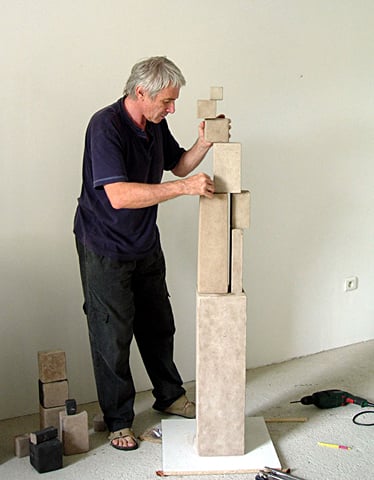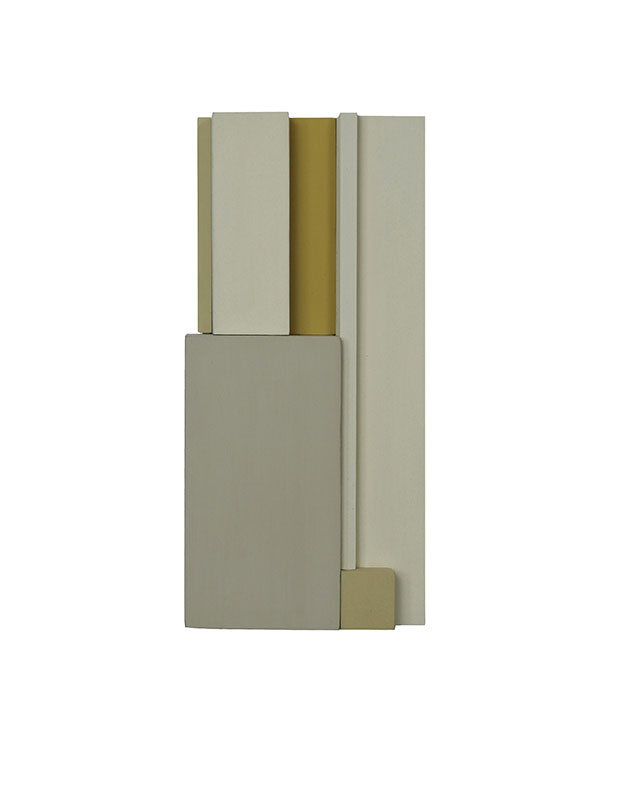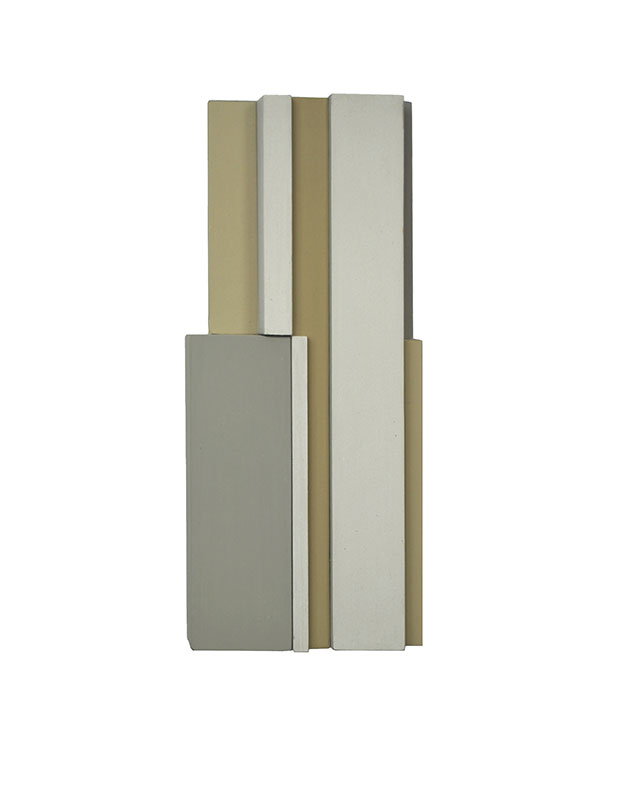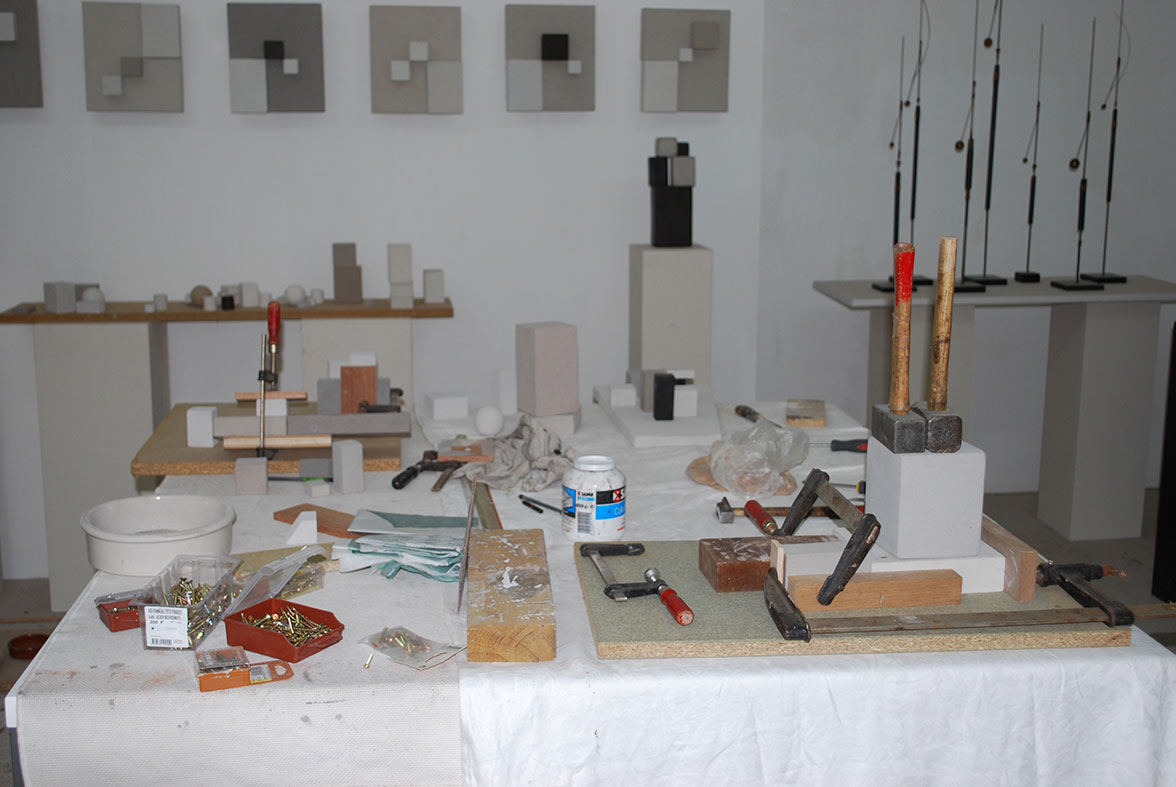Art World
French Sculptor Jean Charasse Discusses His Geometric Vision
Jean Charasse on his artistic process, influences, and current projects.

Jean Charasse on his artistic process, influences, and current projects.

Melanie Boyne

Name: Jean Charasse
Medium: Sculpture, constructed art, mixed media on wood
Style: Geometric Abstraction
Melanie Boyne: How would you describe yourself and the evolution of your work?
Jean Charasse: After a period of 20 years, between 1969 and 1990, I began to abandon the figurative and focus on “baroque” compositions into which I incorporated all sorts of recycled materials, wood, and rusted irons; this was my Signaux et balises (signals and beacons) period. It ended in 2006, at which time, I simplified my constructions, and abandoned wood and iron assemblages.

Jean Charasse, Construction P7D, 2013

Jean Charasse, Construction P8B, 2013
JC: I am self-trained. I owe my artistic training to the 1954 discovery of a book entitled Art Moderne published by Skira, and to my visits to the Left Bank galleries in Paris beginning in 1960.
MB: Who and/or what are your influences?
JC: It was the discovery of Pablo Picasso (Spanish, 1881–1973) that first influenced my work. I then discovered Wilfredo Lam (Cuban, 1902–1982), Paul Klee (Swiss, 1879–1940), and Piet Mondrian (Dutch, 1872–1944). Paradoxically, it’s the Italian Primitive Art of Piero de la Franscesca (Italian, 1410–1492) and Fra Angelico (Italian, b. ca.1400–1455) that allowed me to move forward in my work. In 1994, at the Galerie Alexandre de la Salle, I encountered the work of Aurelie Nemours (Swiss, 1910–2005) and was introduced to Carmelo Arden Quin (Uruguayan, 1913–2010) (founder of the Mouvement MADI in 1946). Since then, a new trajectory in my work has opened up, that of constructed art.
MB: What are you trying to communicate with your art?
JC: There was a long stretch during which time my work, from period to period, became simplified. Early figurations represented childhood traumas, and the “Italian” period was focused on existential angst that, starting in 1990 with the abandonment of figuration, ended up moving to the background. Then came the recycled-material assemblages, Signaux et balises.
The emotions brought on by the verticality of the Manhattan buildings during my third trip to New York, and the towers of San Geminano in Tuscany, inspired my new period, entitled Parallélépipèdes.
MB: Describe your creative process. What kind of creative patterns, routines, or rituals do you have?
JC: My studio is filled with wood elements, cubes, rectangles, etc. I try to assemble these elements on the floor; it can take hours to construct a composition that holds up. Then, I add color, which for me is the most difficult thing because if there is no harmony, the construction will not stand. I think it was Paul Cézanne (French, 1839–1906) who said, “When color is at its richest, form takes on its fullest expression.”

Jean Charasse in his studio, 2010
JC: For the moment, I have not known “artist’s block”; the transitions between each style and inspiration have flowed without interruption, giving me ample time to pass from one to the other without conflict.
MB: Describe your studio or workspace.
JC: My studio is somewhat small. I don’t need a lot of space because my constructions are relatively small. One part of the studio is reserved for cutting wood, another for constructing, often on the floor, and another is reserved for the materials that I place on the wood, as well as a space for my collages to dry.

The artist’s studio, January 2010
MB: When is your next exhibition? Why should we come?
JC: I am working on a new series called Vertical Rhythm. In September, I took part in the Salon des Réalités Nouvelles in Paris.
MB: Has the Internet dramatically changed the dynamic of your business?
JC: The Internet has revolutionized my relationship with the art world. In the past, you had to prepare paper documentation to contact cultural organizations or galleries. In addition, printing pictures took a lot of time and money. Today with the Internet and the digital world, everything has become easier, and the response to your work happens much faster.
MB: What are your favorite museums and/or galleries?
JC: There are many interesting museums. In New York, I have a preference for the MoMA and the Whitney Museum, and in Paris, for the Centre Beaubourg and La foundation Dapper, which features very beautiful African Art exhibitions.
MB: Would you recommend any particular type of training, courses, programs, or books to people interested in becoming artists?
JC: L’Art Moderne, published by Skira in 1953, and Le Primitivisme dans l’Art du 20e siècle, published by the MoMA, with a preface by William Rubin, have had the most influence on my life.
MB: Do you collect art yourself? If so, tell us about your collection.
JC: I own works by several artists, including the Swiss artist Aurelie Nemous, the Uruguayan artist Carmelo Arden Quin, who I like a lot, the German artist Peter Klasen (b.1935), and a lot of works exchanged with other artists of the Art Construit movement. I have also collected African Art for almost 40 years.
MB: What has been the highlight of your career so far?
JC: During each period there have been highlights, which I have had to avoid repeating, because doing so would have been risky and could have lead me to artist’s block. I have a preference for my current work, but everything is subjective. It is perhaps less dramatic than my figurative period, but I find it fulfilling and calming.
MB: If you weren’t making art, what would you be doing?
JC: I was destined for a career in building because both my grandfather and my father worked in this field. Thus, it was without conviction that I studied at the Ecole des Travaux Publics in Paris. Then, I worked in educational institutions for a few years while continuing to paint on the side. It was after the Fonds National d’art contemporain purchased two of my works that I decided to dedicate myself completely to painting.
MB: Are there any creative media you have always wanted to pursue but haven’t yet?
JC: Yes, of course. It would be interesting to work with steel, concrete, and resin-based materials, but I remain an intimate artist. I don’t feel the need to create imposing works. The mixed-media technique I use, with iron oxide bases, acrylics, and ashes, gives my construction a matte and porous aspect that I can’t find in today’s Geometric Art.
MB: If you could have dinner with any three artists, living or dead, who would you choose?
JC: There are so many interesting artists. Today, I have a preference for the abstract. I would choose Mark Rothko (American, 1903–2007) first, whose work leads to contemplation; Cy Twombly (American, 1928–2011), whose 2005 retrospective at the Whitney Museum I had a chance to see; and finally, Richard Serra (American, b.1939), whose gigantic, Minimalist works fascinate me.
This interview was originally conducted in French, and translated by French content manager, Audrey Fair. Click here to read the interview in French.